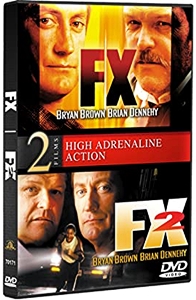Posting from my phone. Will be back as soon as I can.
May 2021
Mon 24 May 2021
Mon 24 May 2021
A Mystery Review by LJ Roberts: J. D. ROBB – Shadows in Death.
Posted by Steve under Reviews[7] Comments
Reviews by L. J. Roberts
J. D. ROBB – Shadows in Death. Lt. Eve Dallas #51. St. Martin’s Press, hardcover, September 2020; paperback, December 2020.
First Sentence: As it often did since he’d married a cop, murder interrupted more pleasant activities.
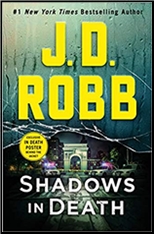
Lt. Eve Dallas, with her husband, Roarke, goes to the scene of a murdered woman. While on-site, Roarke sees a man he knew from his past in Ireland. Lorcan Cobbe, a contract killer, claims he is Roarke’s father’s actual and first son. Lorcan hates Roarke enough to kill him, and everyone he loves. Eve is certain the dead woman’s husband hired Cobbe to perform the hit. Eve’s first task to proving the husband a killer, then stop Cobbe before he kills Roarke.
There are times when one wants an entertaining, captivating read. With her 51st book in the Eve Dallas series, Robb succeeds in creating exactly that. Yes, the plots are somewhat predictable, but the world Robb has created is visual, and the characters are ones about whom readers’ care.
What is remarkable is that the “…in Death” series began in 1995 with the first book set in 2058 and Eve being 30 years old, releasing two Dallas books/year, plus the occasional novella. Shadows in Death is set in 2061; three years and 51+/- cases later, bringing Eve’s clearance rate to ~17 cases per year, or once every three weeks. What police department wouldn’t love that?
Robb has a deft hand when it comes to dialogue, even creating slang that fits for the near-future time period. How clever to use an expression known to readers in the present but would be anachronistic to the period. There are some great lines, and her wry humor is always a pleasure. A discussion on the subtle differences between colors leads to an internal observation— “Peabody turned a little green —perhaps celadon — and turned her head to stare hard at the wall.” Robb carries thoughts through from one scene to another with great deliberateness and ease.
One learns more about Roarke’s childhood and one must respect that Robb, even this far into the series, still has new information to impart. One small irritant is Roark’s references to Eve being “his,” making her seem a possession. However, this is mitigated by the realization that Eve claims Roarke in the same manner and showing it is a manifestation of their commitment of care and protection, and not possessiveness, even including those around them. Yes, the scenes of lovemaking are hot, but they are more about emotion than sex.
Eve is not perfect which makes her more real. She has areas of discomfort and gaps in her knowledge for anything beyond her job or her city— “They look like cops…I need them to look like farmers. Irish farmers,” Eve added. “Who are out there doing farm stuff.”
There is an urgency and intensity to the investigation which gives the sense of needing to run to keep up. The action scenes are visceral, tense, exciting, and filled with twists. They provide excellent examples of Eve’s leadership and authority, and the respect she has earned. Even so, it is not a perfect book. There were opportunities for danger and suspense not taken, and the ending seemed too quick with a final scene a bit silly, albeit satisfying.
Shadows in Death is an excellent remedy to offset the stress and uncertainty of these times in which we live.
Rating: B Plus.
Sun 23 May 2021
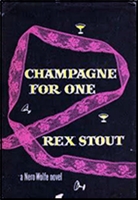
REX STOUT – Champagne for One. Nero Wolfe & Archie Goodwin #31. Viking, hardcover, 1958. Bantam, paperback, April 1960. Reprinted many times since.
Not only was this a long-delayed return visit to the brownstone mansion on West 35th Street for me, it’s also an impossible crime murder mystery — double the pleasure! And the only reason the cops cannot call the death of Faith Usher a suicide is that Archie Goodwin is there and watching as the dead girl is served a single glass of champagne with (apparently) no one else at the party able to drop the fast-acting cyanide into it between the time it was poured and it was served to her.
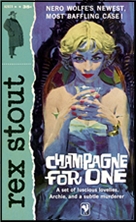
This all takes place at a “coming out” party for a group of unwed mothers, guests of a large philanthropic organization. Nero Wolfe’s investigation, provoked in part to stand up to Inspector Cramer and the District Attorney, who want nothing more to whitewash the affair, shows that the dead girl had no friends, no acquaintances, only a mother she hated and wanted nothing to do with. And hence, no motive.
It’s a baffling case, but if not needing to leave his house, not even once, is a criterion, this is an easy case for Nero Wolfe to solve, culminating in bringing all of the suspects together in the final chapters and having the scene of the crime re-created. That and Stout’s usual smooth and witty way of telling the story — through the lips and mind’s eye of Wolfe’s most trusted assistant — makes this a treat I’ve neglected for far too long.
Sun 23 May 2021
An Archived Western Movie Review: THE SHOOTING (1967).
Posted by Steve under Reviews , Western movies[11] Comments

THE SHOOTING. 1967. Walter Reade Organization, US, 1968. Will Hutchins, Millie Perkins, Jack Nicholson, Warren Oates. Director: Monte Hellman.
This is not, by any stretch of the imagination, your typical, average western. This one is perky, murky, and quirky, Ã la Twin Peaks, of which this is very nearly the cowboy western equivalent. It does, however, except for the ending, which is deliberately obtuse, make more sense.

Two men, apparently miners, are hired by a mysterious women to take her to a town which apparently lies across a desert. She has another idea in mind, however, and the two men soon realize that she is really on the trail of someone. Someone is on their trail, as well.
That someone being a hired killer, played ultra-enigmatically by Jack Nicholson (the most subdued role I can ever recall seeing him play in a movie), and he eventually joins the small group of riders traveling through the sand and the barren hills on a trek that lasts, or so it seems, clear on to forever. (It’s no Lawrence of Arabia, but in a small budget sort of way, it comes close.)

Brian Garfield, in his book on westerns, seems to have been totally mystified by what this movie is about, seeing all sorts of mystical things in it. I couldn’t tell you about the ending – I’m not sure if anybody could – but I didn’t have any problem with the rest of the film, nor should anyone who sees the first ten minutes. It seems like a straight-forward tale of revenge to me, without all the other motivations being spelled out completely (and believe me, this movie has more than most).
Of course, maybe I’m wrong, so when you see it yourself, you’re entirely free to make up your own mind. It wouldn’t bother me. As I hope you can see, it’s that kind of movie. (And if you’re a western fan, see it yourself I think you should).

Sat 22 May 2021
Reviewed by David Vineyard: ROBERT B. PARKER – Chasing the Bear.
Posted by Steve under Reviews[12] Comments
ROBERT B. PARKER – Chasing the Bear. Philomel Books, hardcover, 2009. Speak, paperback, 2010.

It is a Sunday in Boston, and on this particular one while Spenser and Susan Silverman sit on a bench in the Boston Public Garden, Spenser decides to open up about his childhood in the West with his father and three uncles. What follows once in a while almost evolves into a coming of age story, but mostly meanders from one incident to the next of Spenser being Spenser, just a younger version of himself with his Father and Uncles as his wingmen rather than Hawk.
The longest and most involving section involves a teen girl fleeing her abusive father (Jeannie Haden wasn’t my girlfriend. She was a girl who was my friend. We spent a lot of time together. Things were bad at home for her. Her mother and father were getting divorced, and they fought all the time. Jeannie was scared of her father. She only went home when she had to.), and Spenser helping her in the wilderness eventually killing the father. Of course nothing comes of this because the wise deputy is a friend of Spenser’s father, and the man was a near cartoon of an abusive father, so no one really cares a teenage boy killed him in self defense.
It is that kind of book, a Spenser novel in miniature, written for a juvenile audience to give a glimpse of Spenser’s formative years, but by the time the book opens he is already Spenser full blown, and whether protecting a girl from an abusive father or a new friend from racist thugs, only Hawk and the guns are missing.
You would expect in a Hemingwayesque novel of coming of age set in a rural Western setting (“Western Flub Dub†as Spenser describes it) some sense of the outdoors, scenes of hunting and descriptive passages of the world Spenser grew up in, but you barely get that. Like the later novels the book consists of mostly talk, a few descriptive passages of violence, and asides from Spenser about his past, but there is not much more to it than that.
Spenser is Spenser, Spenser kills a man, beats up some bullies, grows up, has a couple of adult conversations, casually mentions blowing a sports scholarship and goes to college. There is precious little about growing up without a mother or the other drawbacks of being raised by four hard fighting sem-literate fathers in the rural West. Characterization is so bare bones you couldn’t cast the characters in a film based on the bare detail provided.
Parker takes 37 chapters to do considerably less than Jim Harrison in the in the novella Legends of the Fall.
Before it starts, I loved Parker and Spenser when they debuted, and I stayed with them much longer than many others I know, but over time I just stopped enjoying the books. There was a sameness about them that I couldn’t remember if I had read one or not, too much cuteness with Susan, too much wisecracking with Hawk, one too many big fights that read like the big fight in the book before.
I recognize that the things I mention are why millions of readers read Parker and still read the continuing series by Ace Atkins and others, and more power to them. For me it was a camel’s backbreaking straw.
I had hoped this would actually give a little insight into Spenser (incidentally we still get no idea he has a first name, for all we find out his father called him Spenser), and sense of how he became the man he was, but instead the boy he was is exactly the same as the man he is, just younger and smaller and needing four Hawks instead of one.
I suppose growing up enough to only need one preternaturally capable killer is some sort of coming of age, but I really can’t imagine many young readers rushing to read this or many older readers being satisfied by it.
I still have great affection for Parker. I loved the early books and still do, loved the Robert Urich series, spent many happy hours with his works, but I can’t pretend the books didn’t wear thin as plot took a farther and farther place in the background.
Spenser even tears up a little at the end as Susan reminds him he has not left his family behind.
I felt my throat tighten for a moment. I nodded slowly.
“Yes,” I said. “With us.”
I only wish Parker had given us enough of a connection to the characters that the final touching tribute actually meant anything to the reader.
Fri 21 May 2021
Mystery Review: ERLE STANLEY GARDNER – The Case of the Hesitant Hostess.
Posted by Steve under Reviews[11] Comments
ERLE STANLEY GARDNER – The Case of the Hesitant Hostess. Perry Mason #41. William Morrow, hardcover, April 1953. Pocket, paperback; 1st printing, September 1956.
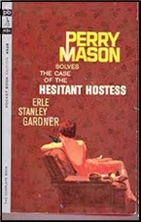
Every once in a while, there is one of the Perry Mason novels which does not end up in a courtroom, with Perry giving D.A. Hamilton Burger his lumps one more time. One such was The Case of the Silent Partner (1940), the TV version of which I watched not too long ago. (And as such it was a shame, as the theatrics in the courtroom is what every reader or viewer always sits back and waits for. Disappointing!)
But as if to make up for that earlier lapse, Hesitant Hostess actually begins with a courtroom scene. It does not go well for Perry, however, as a witness he was counting on disappears from the small room where he had her waiting. Luckily it is a Friday, so he has an entire weekend to track her down and find out why she bailed on him so precipitously.
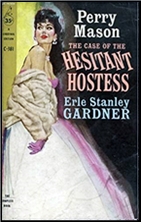
She is a hostess at a local night club – hence the title – and Perry’s first ploy is to pretend that he is a paying customer. There is one long chapter, a rather risque one for a Gardner novel, I should think – in which the curious reader begins to wonder how far the flirtation of sorts will go.
Perry’s client is purely pro bono – a 50ish retiree who is accused of a robbery at gunpoint from one car to another – but that doesn’t mean he doesn’t pull out all the stops in defending him. His bill from Paul Drake – he the private eye with hundreds of operatives working for him – must have ended up in the thousands of dollars.
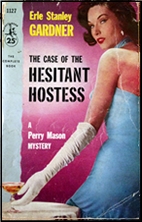
It seems like a very minor case until around page 90 or so, when the police suddenly tie the robbery to the murder of a young woman from a few weeks earlier, and all seriousness breaks out. Even Della Street gets into the act, breaking and entering a suspect’s apartment to do some fingerprint work.
And the plot gets equally confusing – does the missing hostess have a double, a twin sister, perhaps? – but not so confusing as to make the final explanation (almost) intelligible. It’s 100% certified as a doozy, though. This was a lot of fun to read. Recommended.
Thu 20 May 2021
EDWARD S. AARONS – Assignment Bangkok. CIA agent Sam Durell #33. Gold Medal, paperback original; 1st printing, May 1972.

If the listing before the title page is correct, this is #33 in Aarons’ long-running Sam Durell series. Durell is the Cajun-born CIA agent whose adventures ranged over three decades of world disorder, from the dark, dismal days of Europe soon after the Iron Curtain began, on through the era of deep-trenched US involvement in Southeast Asia, and beyond.
His mission in Thailand in this book is on three levels. Ostensibly he is in Bangkok as part of an economic/agricultural advisory team. He thinks he’s there to retrieve another agent who has been investigating revolutionary forces in the northern part of the country. Soon after his arrival, however, he discovers that opposing forces know more about his real mission than he does.
In other words, Durell is in deep trouble from the very first paragraph on. And this is an action story, through and through. And once again, Aarons’ eye for exotic, picturesque detail does not fail the reader: this is a part of the world I have never been in, and probably never will be, but as far as it’s possible, I feel as though I’ve just returned from a prolonged visit there.
Unfortunately, I think that with this number of entries in a single series, Aarons’ zest for a spine-tingling story might have been beginning to fail him. There are plots and subplots, but none of them seem to amount to much. Durell and his cohorts in espionage simply have too easy of a time of it (even though they would never say so themselves, if you ever had a chance to ask.)
All the ingredients are here, but in this book, I think Aarons was only going through the motions.
Wed 19 May 2021
An Archived Western Movie Review: IN OLD SANTA FE (1934).
Posted by Steve under Reviews , Western movies[7] Comments
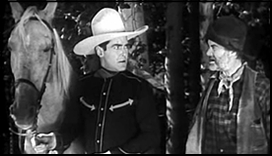
IN OLD SANTA FE. Mascot Pictures, 1934. Ken Maynard, Evelyn Knapp, George Hayes, Gene Autry, Smiley Burnette. Director: David Howard.
This movie was made before Gabby Hayes was Gabby, but not before he was gabby. He’s known as “Cactus†in this picture, and he’s as prickly as old character as he ever was. Key Maynard is the star. He shoots and rides with the best of them, and is bashful around the women (one in particular), but Gene (whose first movie this may have been) outdoes him in the singing category, at least.
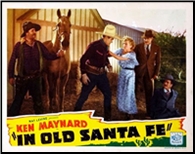
If it weren’t for the songs, the races, the catching of runaway horses and wagons, and the gunshooting, this 64 minute movie would have been 15 minutes long. But in those 15 minutes is hidden a halfway decent detective story: one main clue is a footprint in the dirt; the other is the caliber of the bullet that killed the blackmailer’s number one henchman.
There is also a gold robbery, and Ken is framed for it. He’s also framed for the killing of the henchman. Does he get out of all of these scrapes? Yes and no. At movie’s end the rancher’s daughter has him sewn up as tight as you could please. (To the complete disgust of his grizzled old sidekick named Cactus.)
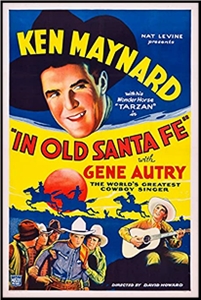
Wed 19 May 2021
An Archived PI Mystery Review: SCOTT MITCHELL – Double Bluff.
Posted by Steve under Reviews[9] Comments
SCOTT MITCHELL – Double Bluff. Brock Devlin #5. Herbert Jenkins, UK, hardcover, 1968. No US edition.

My nominee for obscure title of the month, unless you live in England, since I don’t believe any of Mitchell’s sizable collection of mystery and detective novels have ever been published in the United States. This despite the fact that the hero in most of his books was Brock Devlin, a medium-boiled PI whose main stomping grounds is Los Angeles. (A very strange LA, by the way, one that has kerbs instead of curbs.)
He is also singularly slow on the uptake. In Chapter One, after having a falling out with his girl friend, Devlin goes bar-hopping and during his travels he comes across a strange girl whose name (she says) is Zoe Gordon. In Chapter Two (the disagreement with his girl friend still not settled) he is hired by a conservative Jew-hating industrialist to find the man’s daughter-in-law, a woman by the name of Zelda Ganzer.
Bingo! But not until he sees a photograph of the woman does Devlin make the connection. (They are the same person. I don’t believe that Devlin’s been in as many detective novels as I’ve read. (*)) But even he recognizes this as a gigantic coincidence at best, or (which is infinitely more likely) there is something far more sinister behind it.
And there is. This book is nothing anyone in the US should write their friends in the UK to be on the lookout for, but except for the constant use of the words “baby†and “sweetie,†dating the story more than the author could possibly have recognized when he wrote it, this is a moderately good time-passer.
(*) [WARNING: Subtle Plot Alert ahead.] Well, actually, in violation of Someone’s Laws of
detective story writing – S. S. Van Dine’s? – the sentence before this one isn’t really true, either. It’s probably where the title came from, and believe it or not, I didn’t realize it until right now.
Bibliographic Update: Scott Mitchell was the pen name of Lionel Robert Holcombe Godfrey, (1932- ). He wrote 16 mysteries under this name, all but one of which are known to be cases for Brock Devlin. Under the pseudonym of Elliot Kennedy, Godfrey wrote six more mysteries; in at least five of these a fellow by the name of Griff Dexter was the leading character. Other than the fact that his adventures also took place in the US, primarily in Los Angeles, I know nothing about him.
Tue 18 May 2021
The F/X Movies, Reviewed by David Friend.
Posted by Steve under Action Adventure movies , Reviews[5] Comments
Reviewed by David Friend
Just over a year ago saw the passing of American Golden Globe-winning actor Brian Dennehy, best known for his roles in Rambo: First Blood, Cocoon, Romeo + Juliet and the two fondly remembered F/X action thrillers. In a weird coincidence, I had only seen this pair a couple of weeks previously – they had passed me by for years – and this may be a good excuse as any to share the love.
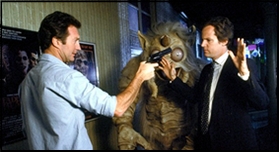
The first film, 1986’s F/X: Murder By Illusion, was a hit at the box office and went on to become the biggest-selling film in video rentals. Critics loved it too, including Roger Ebert, and it now enjoys an impressive 88% rating on Rotten Tomatoes. It was followed by a sequel and a short-lived television version, while a remake has been in the offing for the last decade. So, keen to see what I’d been missing out on, I set the DVD and waited to be impressed. And colour me thus.
Hunky Australian Roland “Rollie” Tyler (Bryan Brown) works in the American film industry as a special effects artist. You should see his flat. It’s full of alabaster heads and mannequins that look like murdered spouses. He’s so good at his job, in fact, that Department of Justice agent Martin Lipton (Cliff DeYoung) wants his help in faking the murder of a mob informant named Nicholas DeFranco (ironically, Law and Order’s Jerry Orbach), before the mafia do it for real.
Rollie reluctantly accepts the assignment, fixes DeFranco up with fake blood packs and even gets talked into playing the killer by head honcho Edward Mason (Mason Adams). The staged hit at an expensive Italian restaurant goes as planned and Rollie believes his part is over – until Lipton tries to kill him as a “loose endâ€. Rollie escapes, but as more blood is spilled – the real stuff, this time – he is forced to confront a conspiracy which involves some very corrupt lawman and many millions of dollars.
Fortunately, Rollie is resourceful, with a career’s worth of Tinseltown trickery to surprise and snare his murderous pursuers. Meanwhile, middle-aged maverick homicide detective Lt. Leo McCarthy (Dennehy) becomes suspicious of DeFranco’s supposed death, but his investigation is frustrated by senior officials who have the power to keep their secrets buried – along with anyone who gets too interested.

Although somewhat hampered by an enigmatic title, the film has a shrewd, playful script and a convincing turn from purse-lipped Bryan Brown, here caught between his breakout role in the Australian mini-series A Town Like Alice and Tom Cruise’s bottle-juggling juggernaut Cocktail (also, somewhat less illustriously, a supporting role in the vacuous Paul McCartney vehicle Give My Regards to Broad Street).
Early on, his ineffective flailing with a wily sniper demonstrates just how alien Rollie is in a world of cold kills and glibly indifferent corruptors, yet his ingenuity with practical illusions quickly evens the odds, and it’s then that the film goes from a conventionally Hitchcockian man-on-the-run thriller to one which is confident enough to throw some black comedy and charismatic character business among the squealing car chases.
Rollie is an everyman, and confident in his abilities, yet the script doesn’t bother explaining the specifics of his armoury, but instead lets him deploy each trap – which is what they manifestly become, original usage be damned – to the gleeful surprise of the audience.
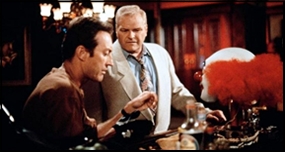
Running alongside all this is the police investigation, coloured by Dennehy’s roguishly charming renegade, but anyone hoping that these two characters will meet and spar will be disappointed as the threads don’t link up until the end. As such, the narrative may risk becoming disjointed yet avoids it, more or less, by slowly explaining the mayhem which Rollie is experiencing elsewhere. This makes it different from, say, The Fugitive, which gave us lawmen searching obsessively for our hero, and North By Northwest, which omitted the chase entirely.
The film isn’t without its flaws, however. Although there are some charming scenes between a gently flirtatious McCarthy and savvy computer geek Marisa Velez (Jossie DeGuzman), a couple of other promising characters are perfunctorily dropped, including a guileless sergeant (amusingly played by Joe Grifasi) and original antagonist Lipton.
More awkwardness is found at the climax. At first, it’s handled well, with yet more slickly mischievous pyrotechnics, and the main bad guy is disposed of in a particularly clever way, yet we’re afforded an unnecessary postscript which robs the story of a satisfying, slam-dunk conclusion.
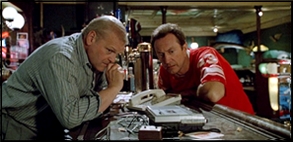
The sequel, 1991’s F/X: The Deadly Art of Illusion, wasn’t as well received, but there’s still plenty to enjoy and in some ways it’s better than the first. I love sequels (it’s even my favourite word) as it means we get to spend more time with characters we like, and this time they do too, sparing together like they couldn’t before.
The plot again sees Rollie enlisted to work his movie magic on a police sting, one involving a rapist who has served time in prison yet is too dangerous to remain free. Things go wrong, of course, and, as before, Rollie discovers it was an inside job, the bad guys want him dead and he relies on his technological know-how and smart survival tactics to stay alive.
The recipe, then, is largely the same, but with a couple of new ingredients. There’s a scheme involving antique gold medallions crafted by Michelangelo which is very National Treasure, and a couple of truly novel action sequences, most memorably a chase around a supermarket in which baked beans prove every bit as dangerous as natural uranium, and a surreal yet surprisingly exciting fight against an imitative robot clown.
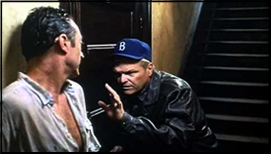
However, in giving the hero a distinctly technological approach to combat, as opposed to letting him use his fists (perhaps he’s a pacifist, but what this man can do with an aerosol spray would impress MacGyver), the script forces him to do this every time. At one point, instead of simply bonking some henchmen over the head, we’re expected to believe he has previously infiltrated the villain’s heavily-guarded house in order to set traps which shall enable him to infiltrate it again.
It’s a paradox worthy of Steven Moffat-era Doctor Who. Of course, that’s the nature of the beast, and writer Bill Condon (future Oscar winner of such impressively diverse films as Chicago, Mr Holmes, the last two Twilight films, Kinsey and The Greatest Showman) does all he can to keep it roaring. By the end of this sequel, the premise may seem a little tired, but it’s a solid one nonetheless, with both films playing out like an adult, city-wide Home Alone, somehow balancing psychological realism with a wry sense of humour. And, like most of Rollie’s gadgets, it makes for a neat trick.
